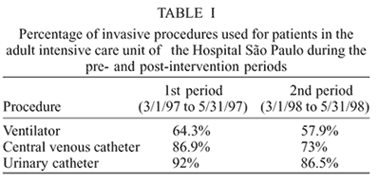Multi-resistant gram-negative rods are important pathogens in intensive care units (ICU), cause high rates of mortality, and need infection control measures to avoid spread to another patients. This study was undertaken prospectively with all of the patients hospitalized at ICU, Anesthesiology of the Hospital São Paulo, using the ICU component of the National Nosocomial Infection Surveillance System (NNIS) methodology, between March 1, 1997 and June 30, 1998. Hospital infections occurring during the first three months after the establishment of prevention and control measures (3/1/97 to 5/31/97) were compared to those of the last three months (3/1/98 to 5/31/98). In this period, 933 NNIS patients were studied, with 139 during the first period and 211 in the second period. The overall rates of infection by multi-resistant microorganisms in the first and second periods were, respectively, urinary tract infection: 3.28/1000 patients/day; 2.5/1000 patients/day; pneumonia: 2.10/1000 patients/day; 5.0/1000 patients/day; bloodstream infection: 1.09/1000 patients/day; 2.5/1000 patients/day. A comparison between overall infection rates of both periods (Wilcoxon test) showed no statistical significance (p = 0.067). The use of intervention measures effectively decreased the hospital bloodstream infection rate (p < 0.001), which shows that control measures in ICU can contribute to preventing hospital infections.
intensive care unit infections; multi-resistant gram-negative bacteria; Pseudomonas aeruginosa; Acinetobacter baumannii


